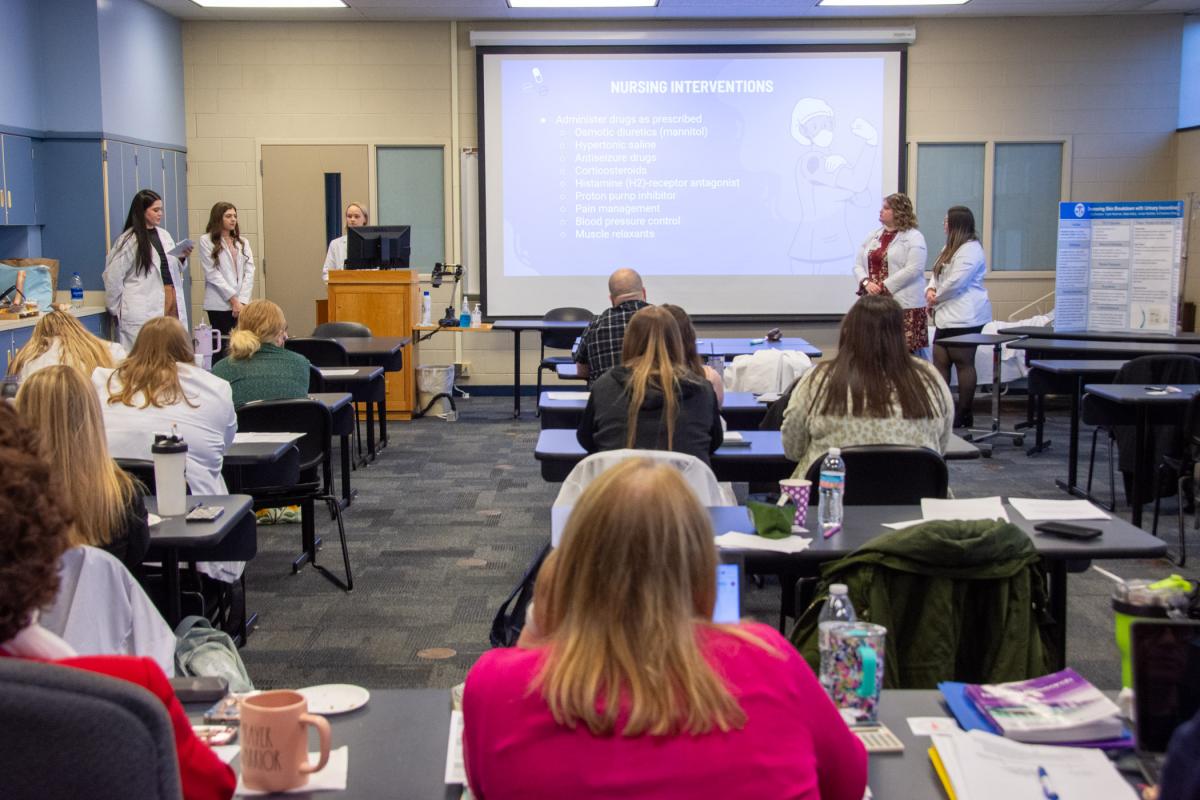Graduating nursing students brainstorm 'What can be done better?'
Wednesday, December 6, 2023
Photos by Jennifer A. Cline, writer/magazine editor
Soon-to-graduate Bachelor of Science in nursing students recently presented research that integrated their final three courses: Adult Health Nursing III, Leadership & Management in Nursing, and Research & Theory in Clinical Practice.
After helping to care for patients at clinical sites during their Adult Health Nursing III course, students questioned a practice they saw. They applied their budding research and leadership skills to determine how best to serve patients in similar situations and develop a plan to implement or change protocols.

The bachelor’s degree nursing major’s December graduating class gathers during a break between poster presentations.
The capstone assignment prepares students to be an active part of the continuous-improvement environment of the workforce. To attest to its importance, Daria Datsenko, who sat in the students’ shoes just four years ago as a December 2019 nursing graduate, attended. Datsenko is a registered nurse for Evangelical Community Hospital and served as a coach for one of the groups.
“We have our quality improvement groups and our nurse educator, and we are constantly evaluating what can be done better,” she said.
She attended both to support the Penn College students she worked with and to learn from their research findings.

A team exploring the optimal timing for use of the CIWA-Ar Scale comprises (from left): Kalen I. Corter, Faith N. Myers, Rachel Hoffman, Morgan E. Young and Harlee G. Emery.
Students and their research topics:
Early Implementation vs. Symptom-Triggered Implementation of the CIWA-Ar Scale in Patients Experiencing Alcohol Withdrawal
- Kalen I. Corter, of Williamsport
- Harlee G. Emery, of Wellsboro
- Rachel Hoffman, of Muncy
- Faith N. Myers, of Bridgeport
- Morgan E. Young, of DuBoistown
The group conducted a study to evaluate the effectiveness of implementing the CIWA-Ar Scale upon hospital admission, compared to when symptoms appear, for patients with a recent history of alcohol use who are admitted to the intensive care unit and may be at risk for alcohol withdrawal.
The Clinical Institute Withdrawal Assessment Alcohol Scale Revised is an instrument used by medical professionals to assess and diagnose the severity of alcohol withdrawal, which enables them to prevent further health complications and treat the withdrawal symptom accordingly.

Students studying targeted temperature management (from left): Brianna I. Benedetti, Kathleen Ross, Adriana Yaskoweak, Sean Buckman, Skyelar K. Splain and Jordan Specht.
Targeted Temperature Management in Post-Cardiac Arrest Patients
- Brianna I. Benedetti, of Williamsport
- Sean Buckman, of Williamsport
- Kathleen Ross, of Mifflinburg
- Jordan Specht, of Frederick, Md.
- Skyelar K. Splain, of Liverpool
- Adriana Yaskoweak, of Williamsport
After helping to treat a patient who experienced cardiac arrest, the students completed a study to compare the effectiveness of targeted temperature management at 36 degrees Celsius as opposed to less than 36 C on neurological outcomes of post-cardiac arrest patients.
Targeted temperature management refers to the therapeutic lowering of core body temperature, which helps to improve survivability and preserve neurologic function in cardiac arrest patients (and some others).

The group exploring the best method to prevent skin breakdown (from left): Jordan Mutchler, Taylor J. Heckman, Blaze A. Kelley, Charisma C. Weaver and Eliza D. Davidson.
Decreasing Skin Breakdown With Urinary Incontinence
- Eliza D. Davidson, of Clarendon
- Taylor J. Heckman, of Selinsgrove
- Blaze A. Kelley, of Williamsport
- Jordan Mutchler, of Montoursville
- Charisma C. Weaver, of Mifflinburg
The group conducted a study to determine whether adult briefs or external catheters are more effective in the prevention of skin breakdown in adult critical patients experiencing urinary incontinence. Skin breakdown is erosion, irritation or inflammation of the skin.

Buckman discusses targeted temperature management.

Davidson (left) details a case the students observed during their clinical experience.
